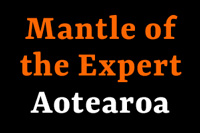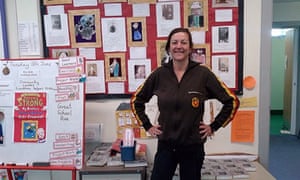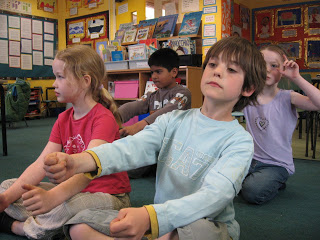Here’s the second of three conversations with Hākon Saeberg from Iceland who has been talking about his experiences teaching Mantle of the Expert with year 4 students. If you missed the first part, it can be seen here. When Hākon and I reconnected, he had just embarked on the Mantle and was three days in. He had gone ahead with the idea, previously discussed, of imagining an island that is suffering through sea level rise. The class had spent the first three days creating the island that would disappear.
Viv: So why did it feel like a good idea to start this way this time?
Hākon: I thought it would be important to try and create an emotional investment for the students towards the island. I was hoping that this would make the news that the island will disappear more dramatic.
Viv: What conventions of drama have you used so far to create the island?
Hākon: We spent time creating the central space of the island, so we could create a shared view of the place, we created stories of the island so we could have a shared vision…This is the first-time that the children have done lots of the groundwork when starting a Mantle.
Viv: Clearly you have spent time building the emotional connection to the imagined world, so when will you bring in the idea that this place is under threat?
Hākon: Today they got the news that the island will disappear. The King (teacher in role) delivered the news. He said he was scared and didn’t know what to do.
Viv: How did the children react?
Hākon: At first, they thought they could do miracle solutions, for example stopping the rising sea levels by recycling. I think this is because in my previous mantles there have been miracle solutions like this, but then I went into role as a top scientist and confirmed there was nothing we could do.
Viv: How did this go down?
Hākon: The children were quite thrown, and you could sense their uncertainty. However, I feel similarly, as I’m finding it a struggle to think of where I go next.
Viv: Perhaps it would help to have some out of role reflection to give them a chance to discuss how this experience is different from past Mantles. A big part of this approach is the chance to step back and articulate how the learning is going – what’s challenging etc.
Hākon: That might be the best way to go. This way I could also try to better understand how the students feel about the story so far. It’s quite different than any other mantle I’ve done. But, I’m also still grappling with the question of what kind of expert team the children should be. Should we work as lots of little teams all tackling different parts of the resettlement process?
Viv: Well, let’s think about who a leader of a country who was in this situation would call on in real life. It would be many different teams, in fact, wouldn’t it? There would be cartographers – to map out the unexplored land, there would be historians – to advise on the important parts of the existing history and culture of the country that should be preserved, there would be artists to create artworks to express the cultural identity. While you could divide the class into multiple teams to explore all these things (this is something like the ‘rolling role’ approach), it’s an awful lot of work for one teacher to ensure the learning is deep in each area, plus there’s a danger that not every child learns about every aspect. If you want to work with the unified community of learning of a single team, the challenge is to find an expert frame that everyone can be in together and that gives you a perspective on the issue that takes you to the curriculum areas you want to explore. We talked about some other options last time, didn’t we?
Hākon: I think I will make them city planners who are asked to create a map of the new capital city. The map would have to include the structures of government, the culturally significant buildings and the religious centres – these are all the aspects of society I want us to study. And if the commission included a requirement to honour the history of the old island, this could focus things nicely.
Viv: Sounds great. How will you deliver the commission, and who will be your client?
Hākon: I guess the king will be the client. As for the commission, these kids really enjoy receiving an email, but since the people on the island are a bit old-fashioned I might use a letter.
Viv: Let’s talk about some drama possibilities, too. What if you went back in to role as the King, and asked the children to step in to a sort of ‘shadow role’ as ‘wise people of the island’ to offer their advice. That way, the group could explore all sorts of possibilities for the future of the country and the children could get a sense of the magnitude of the decision the king is facing.
Hākon: That’s a great idea. This could also lead to the children creating their own commission in a way, by recommending it to the king.
Viv: It’s also important to add that stepping in to shadow role as the islanders probably won’t confuse the children. They know that their main identity within the mantle is as the expert team – the city planners – carrying out the commission. That’s because you will take time to build belief in the expert team identity and you’ll keep returning to it, unlike shadow role which you just step in and out of. Does that make sense?
Hākon: Definitely. I have used ‘shadow roles’ before to some extent so the children are used to it. I think it will also help, in this case, that the children have not yet gone into role as the city planners, so there shouldn’t be much confusion once we go into that role. Talking of building belief in the company, or responsible team, do you have any suggestions for doing this in a new way? I’m familiar with the idea of designing the office space and stuff. What are some other ideas that you like to use?
Viv: One strategy I use a lot is one I was taught by Brian Edmiston. This involves asking them to draw a favourite part of the office and then talk about how this space represents the values of the company. For example, I remember a recent company where someone drew a sign showing the way to the childcare centre. He spoke about how this signified we were a family-focussed organization with a systematic approach to supporting women in the workplace. So, yes, that can be a nice strategy. You can also design the company’s main door way.
Hākon: Yes, I have tried that before, and I have written letters from previous clients.
Viv: Awards can also be good. I had one Mantle where the team received an award from the government for their previous work. This gives the opportunity to think about what would be on the citation and sets up the idea that we are obviously successful and experienced.
Hākon: OK. I feel like we have a sense of where to go next. The children will take on the role of elders which will hopefully lead us into the commission. Thereafter we will start the expert framing as city planners. Just thinking ahead to possible tensions. What issues or tensions could be appropriate?
Viv: Well, let’s think of some possibilities. When I’m planning for tensions I will often go to Heathcote’s handout ‘working with tension’. Or sometimes I just think, ‘what if…..’ So, let’s try that. If we are setting up a new society, what problems might arise…?
Hākon: What if…. There are differences of opinion about which form of government would be right? When the children were creating the island, they decided that it was governed by a king? What if they would rather want a democracy? Or what if they don’t like democracy? I think it could be fun if they choose anarchy!
Viv: And of course, there’s religion too…. What if there’s a conflict within the new society with a dominant religion that doesn’t want others to be included? What if there are objections to the iconography? That could bring up a whole lot of interesting curriculum.
Hākon: And environmental issues – what if there are problems in the new country related to the use of land. Or getting rid of waste?
Viv: Lots of possibilities. You don’t need to decide what to use just yet, but it’s good to have some of these up your sleeve as the Mantle progresses.
Hākon: Fantastic! I feel these talks are incredibly helpful and I’m learning a lot.
Viv: All the best with the next phase. Just one more thing… How are your teaching colleagues finding it? Are they enjoying it as much as you are?
Hākon: They are a little concerned about how slowly the class is moving at the moment while we build belief in the imagined world. It will be good when we start moving faster!
Thanks so much for sharing your thoughts with us Hākon – we look forward to part three where we hear how the Mantle finished up.




